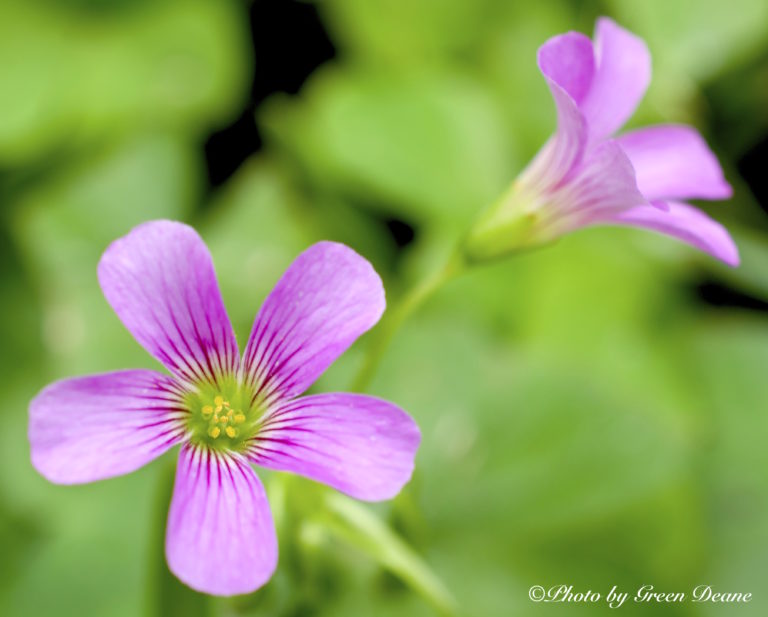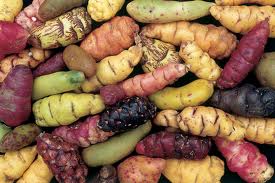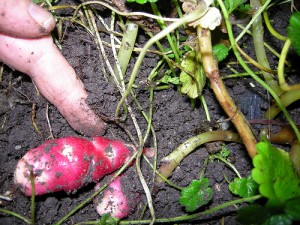Sorrels are like McDonald’s restaurants: No matter where you are on earth there’s one nearby.
That’s because the sorrels, properly Oxalises, comes from a huge family. What’s huge? There are some 850 different species of them, according to the Encyclopedia Britannica. No, that’s not a record. The biggest family is the Composites, you know, plants like sunflowers and daisies. There’s over 20,000 in that family, maybe more, no one really knows for sure. Still, an Oxalis (ox-AL-iss) is found at every location on the rotation except at the north and south poles. They are about as wide spread as mustards are. There are at least seven species in Florida, all edible, three of them rare — don’t eat those — and they have either pink or yellow blossoms, one of which has the good taste to sprout up in my garden. I live mid-state right on the line between temperate and subtropical so many plants said to be in the state are often 200 miles farther north in temperate or 200 miles farther south in tropical.
When you have a family of plants that’s 850-strong, and folks don’t know enough to eat them, you also get the other view: That the Oxalis is not a delicate, pretty little greenerific morsel but a pernicious ugly weed that uses up your water, fertilizer and garden space. Once an Oxalis gets a roothold in a garden, it’s there forever, which brings up a touchy point: Gardeners who complain the most about weeds are also usually the last group to consider eating the weeds. It’s kind of like they are for controlled green but not natural green. To me an Oxalis in my garden is food I didn’t have to plant. As long as it’s growing where I want it to grow there’s no issue. If it isn’t, it’s not a weed: It’s dinner. Sorrel is the first wild plant I saw someone other than my mother or grandmother nibble on. A childhood friend of mine named Peter Jewett called it “sour grass” a common name for it. We used to play on a small island in a small brook in the Maine woods. It grew profusely there and was the fort’s “food supply.”
Here in Florida our several versions keep changing names: O. articulata, corniculata, debilis, latifolia, macrantha, triangularis and violacea. O. corniculata used to be O. stricta, O. debilis was corymbosa. The rare ones are O. articulata, triangularis, and violacea. All parts are edible including the root bulb, which is succulent and can be sweet. Above ground it tastes much like rhubarb but not as tart. The C. violacea occasionally has, in the words of Merritt Fernald, author of Gray’s Manual of Botany, “an icicle-like water-storage organ or fleshy root.” In other parts of the world, Oxalis tuberosa is popular not only as a green but as a root vegetable.
Sorrel is from the High German word “sur” meaning sour. Oxalis is from the Greek though the accent is on the end: ox-al-IS, base word (Οξύς, pungent) The Oxalis is mildly tangy because of …oxalic acid… now there’s a surprise. Articulata (ah-tic-you-LAH-ta) is jointed, Corniculata means, creeping, much branched like a mat, debilis is weak, Latifolia means broad leaved, Macrantha large flowered, Violacea (vye-o-LAY-see-uh) like a violet, Triangularis, triangle shaped, and Tuberosa (too-ber-ROW-sa) means tuber. Oxalises can grow individually or in colonies, and if you have one there will be colonies. They are refreshing to nibble on, are nice additions to salads, and can be made into an ade. Their tangy flavor is both positive and negative. A little is good, but a lot when eaten uncooked, to excess, can leach some calcium out of your bones. (Yes, you would have to consume it like a force-fed lab rat for months, but it can happen.) Kids can eat too much as they do green apples and get a tummy ache from it. Watch their consumption.
Cooking plants with oxalic acid reportedly renders them harmless, and that’s what has been done with other plants containing oxalic acid, such as docks and sheep sorrel, both Rumex and in the buckwheat family. This is particularly true if any form of calcium is used — milk for example — or included in other food. A good use for this plant is stuffing that trout you just caught and are cooking over the fire.
Every book on wild foods warns us not to consume too much oxalis acid, but that’s to keep the accursed lawyers happy. ( Shakespeare was right.) It is true that folks with kidney stones, gout and the like should not over-consume oxalic acid. Yet, when was the last time you read or heard of such a warning for tea, parsley, rhubarb, carambolas, spinach, chard, beets, cocoa, chocolate, nuts, berries, black pepper and beans? They all have oxalic acid as well, but no dire warnings are given with them. The French are not succumbing from sorrel soup slurping. As my Greek ancestors used to say some 3,000 years ago, μέτρον άριστον, [ME-tron A-ri-ston] all things in moderation.
Lastly, the Internet calls Oxalies “clover” which is completely wrong. Different genus, different shape if you look closely.
Below is an Oxalix Cooler recipe from Sunny Savage
Oxalis Cooler
1 quart water
1/2 cup Oxalis leaf/stem/flowers/seedpods
1 Tablespoon agave nectar or honey
dash of salt
Mix all ingredients in a blender. If possible, let sit overnight in refrigerator and enjoy!
Green Deane’s “Itemized” Plant Profile
IDENTIFICATION: Perennial growing to ix inches, three leaves, some times very delta shaped, other times round or lance shaped, depending upon the species. Pink and or yellow blossoms in Florida
TIME OF YEAR: Grows and flowers year round in Florida, July to September in more northern climes. Very prolific in February and March in Florida.
ENVIRONMENT: Anywhere moist but well drained, lawns, woods, trails, parks.
METHOD OF PREPARATION: Leaves and stems in salad, or made into ade or soup. Use as a stuffing for fish and chicken or ferment like a sauerkraut. If you cook oxalis best to use a glass or ceramic pot. Like all plants with oxalic acid should be used in moderation. Some people may be allergic to it. The juice can be used to coagulate milk for cheese making. See my article on rumex.





